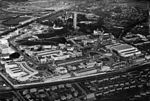Benburb F.C.
1885 establishments in ScotlandAssociation football clubs established in 1885Benburb F.C.Football clubs in GlasgowFootball clubs in Scotland ... and 4 more
GovanScottish Junior Football Association clubsUse British English from May 2015West of Scotland Football League teams
Benburb Football Club is a Scottish football club, based in Govan, Glasgow. Formed in 1885, the club is a member of the Scottish Junior Football Association and currently competes in the West of Scotland Football League. Benburb's colours are blue and white. The team have been managed since July 2015 by former Airdrie defender Paul Lovering. Paul succeeded his father Frank who had been in the job for the previous thirteen seasons.
Excerpt from the Wikipedia article Benburb F.C. (License: CC BY-SA 3.0, Authors).Benburb F.C.
M8, Glasgow Craigton
Geographical coordinates (GPS) Address External links Nearby Places Show on map
Geographical coordinates (GPS)
| Latitude | Longitude |
|---|---|
| N 55.85209 ° | E -4.326006 ° |
Address
Benburb F.C.
M8
G51 4DA Glasgow, Craigton
Scotland, United Kingdom
Open on Google Maps





